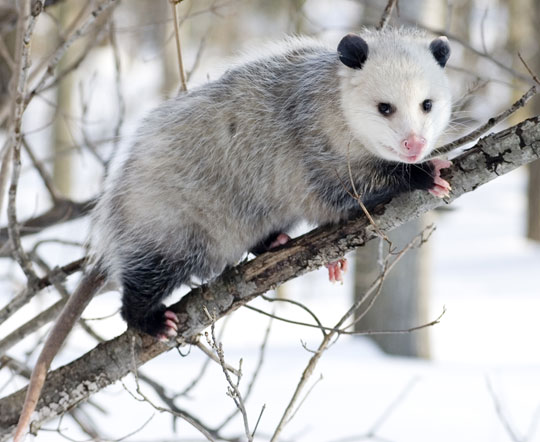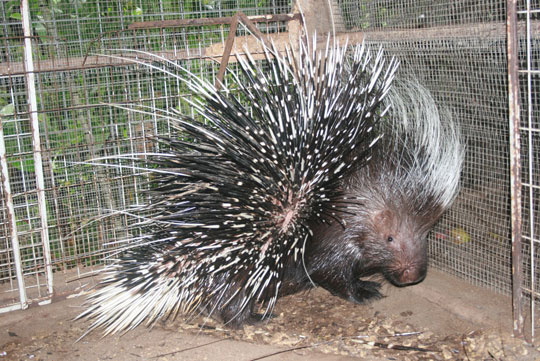In the natural world, almost every animal has its own tricks to survive. Some creatures are "defensive" masters with impressive escape secrets and "no touch".
Weasel Opossum: pretending to die

Never be fooled by the seemingly harmless appearance of the weasel Opossum's soft fur because when it comes to defense, this animal is really super genius. Opossum weasels often react to danger by pretending to die: It falls to the ground, foaming at its mouth as if it is seriously ill, then lying motionless with its open mouth and releasing smelling green liquid. rancid from the anal glands. The strangest thing about this animal's defense mechanism is that, the psychological response, subconsciously more dangerous than conscious reaction. Because predators often prefer to kill prey, they are not interested in prey that seems lethargic and often leaves. Score 10 for weasel Opossum about wisdom.
African crested porcupine: launch sharp feathers

Hedgehogs with African crests have given the term " acupuncture " a whole new meaning. When threatened, these mischievous creatures ruffled their feathers and made them clatter their way to make their bodies look bigger and panic to avoid. If the above fails, the hedgehog will try to raid the back or flank and release sharp feathers into the enemy. Or, it could stop abruptly, causing the enemy to crash into its furry fur. The porcupine hairs are easily separated from the " parent " body and once they penetrate into the body of predators, the small hairs on the ends of the hair really make them deeper into the wound, breaking blood vessels. and even internal organs. These attacks were recorded to kill both lions, leopards, hyenas and even humans. There is an interesting fact: these porcupines have natural antibiotics in their bodies to prevent them from getting infected if they fall from the tree and accidentally stab their hair.
Fur frogs: grow claws at the feet

Do you remember the werewolf character in Hollywood's " X-men " blockbuster and his famous claws? The werewolf looks so powerful and attractive when the sharp claws pierce the skin between his knuckles and expose, despite all the logic of human physiology. But when a hairy amphibian with a " less eye-catching " appearance looks like it works, it looks scary. When felt danger, the fur frog will actively break its bones to create claws that pierce the underside of the feet, exposing it. It is believed that the hairs of the frog legs are shaped like a sharp nail and connected to a certain muscle. When the muscle shrinks, it pulls the claws down, separating from the rest of the bone and protruding from under the feet.
Ants Malaysia: "bombing" suicide

These small, loyal members of the insect class have a sense of protection for their territory so high that they are willing to commit suicide and blow up their bodies into thousands of pieces of organic dust if they feel threatened. Therefore, they are not only effective in destroying enemies but also destroying themselves. It is possible that Malaysian ants are not the smartest creatures to deprive themselves of their lives but are admirable for their dedication and sacrifice for their small herds. The unique feature of Malaysian ants is that this animal has large glands filled with toxins in the body. When sniffing sees an attacker, they signal and release the glands that contain toxins on their heads to burn, explode and spray poison everywhere. What an impressive " suicide bombing " technique.
Squirrel mouse: self-severed tail

The small and lovely appearance makes it hard for anyone to hurt the squirrel mice. However, this is really a defensive " master " and they are always ready to resist all attacks with a secret strategy. Usually, squirrel mice try to run away from predators or bite back. However, when the above measures still fail, it is time they turn to plan B: sacrificing part of the body according to an automatic protection mechanism. If you pay attention, you will see that the skin on the tail of the squirrel is very scary. And if the predator attacked and grabbed this small animal, the skin would peel off, allowing them to escape. Isn't it great? But one point to note is: Squirrel can only use this tip once in its lifetime because after the skin peels off, the bone remains or is cut by the rodent itself or falls on its own. come out naturally.
Lazy cunt: self-covered venom on the body

You may have never heard of slow loris, but this is a way to describe them: a venomous primate. As the name suggests, lazy loris are extremely slow moving creatures, making them become vulnerable prey. To compensate for their inherent slowness, they are equipped with a super-powerful weapon to withstand the danger. This animal has venom-containing glands on their elbows. Oddly, the loris lazy makes the opponent stay away by licking their elbows, covering the venom all over themselves and even their children before leaving the children to get food. One more special thing about this animal is, they are capable of snake-like: licking and sucking venom into their mouths, then biting and transmitting venom into the enemy, making these opponents an anaphylactic shock or death.
Potato bug larvae: self-fertilize the body

Larvae of potato beetles can be a menu item of hungry birds and grasshoppers. Because it has not developed an external hard shell until adulthood, in order to protect themselves from being eaten by larger animals, these immature creatures try to make them less attractive by their feces. mine. Stool is generally waste, smelly and extremely toxic to any object and is definitely not a good thing. Therefore, the potato beetle larvae cover their own body is really a perfect protection shield.
Sea cucumber: upside down and change body state

Those who have admired the villain's ability to mold themselves into any unbreakable form are liquid metal robots in the movie " Terminator 2 " that will definitely be extremely excited. " Talent " of sea cucumbers: When attacked, this creature can change its body state, turning them from solid to liquid and vice versa for a few milliseconds. Not only that, they also have the ability to melt the body into a sticky, sticky slime, seep through the crevices and cracks, then recombine into small lumps. The more amazing thing is that sea cucumbers have the ability to self-reverse the body from the inside out so that their toxic digestive fluids can poison and kill the enemy.
Myring: Grouper

The mezzanine grouper is an underwater creature with an elongated eel-like body. When attacked, they fight off enemies by releasing large amounts of sticky grease that becomes a solid gel when combined with water. Then, they clean themselves with a motion squeezed from head to tail, eliminating all lubricants. This special action helps them to free themselves from the mouths of predators. Concentrated slime not only disperses the enemies of the mezzanine grouper but also encapsulates smaller organisms in a jelly-like mass of mucus, causing them to suffocate. An adult mezzanine can produce a sufficient amount of slime to turn a 20 liter tank of water into solid gel in minutes. And every time it excreted, it could produce the amount of mucus that filled a glass of milk.
Lizards with horns: spray blood from the eyes

Watch out for this little creature! Unlike other lizards, horned lizards are strange, thorny and anteater. They have a variety of defense mechanisms to avoid being eaten as camouflaged, bulging the body or running in short steps to confuse the enemy. However, the most strange defense mechanism is when they protect themselves by spraying blood from their eyes on the attackers. This mechanism takes place through increasing pressure in the sinus cavity until the blood vessels in their eyes burst, shooting blood into the predator with the accuracy of the sniper rifle.
 Animal 'suffering' after hibernation
Animal 'suffering' after hibernation Why do goats climb well?
Why do goats climb well? Scientists were surprised to see chimpanzees eating turtles
Scientists were surprised to see chimpanzees eating turtles Giant catfish died deadly due to drought in Thailand
Giant catfish died deadly due to drought in Thailand